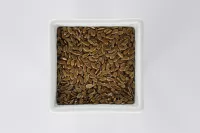The Science Behind the Brown Food Diet
The Brown Food Diet is not just a passing fad. It is rooted in scientific evidence that supports the health benefits of incorporating brown foods into your diet. Brown-colored foods often contain high amounts of fiber, which is essential for maintaining a healthy digestive system. Fiber helps to regulate bowel movements, prevent constipation, and promote overall gut health. Additionally, the natural compounds found in brown foods, such as flavonoids and antioxidants, have been shown to have anti-inflammatory and disease-fighting properties.
One particular group of brown foods that has gained attention in recent years is whole grains. Whole grains, such as brown rice, quinoa, and oats, are packed with vitamins, minerals, and fiber. They have been linked to a reduced risk of heart disease, type 2 diabetes, and certain types of cancer. The complex carbohydrates found in whole grains also provide a steady release of energy, keeping you fuller for longer and preventing blood sugar spikes.
Incorporating more brown foods into your diet can also help with weight management. Many brown foods, such as nuts and seeds, are rich in healthy fats that promote satiety and help control cravings. The fiber content in brown foods also aids in weight loss by keeping you feeling satisfied and reducing overeating. By choosing brown foods over highly processed, low-nutrient options, you'll be nourishing your body and supporting your weight management goals.
Health Benefits of a Brown Food Diet
The health benefits of a Brown Food Diet are vast and varied. By incorporating more brown foods into your meals, you can experience improved digestion, enhanced heart health, and better weight management. Let's take a closer look at some of the specific benefits:
1. Digestive Health:Brown foods, especially whole grains and legumes, are rich in fiber. This dietary fiber adds bulk to your stool, making it easier to pass and preventing constipation. Additionally, fiber acts as a prebiotic, providing fuel for the beneficial bacteria in your gut and promoting a healthy gut microbiome. A healthy gut is essential for digestion, nutrient absorption, and overall well-being.
2. Heart Health: The high fiber content in brown foods, particularly whole grains, helps lower cholesterol levels and reduce the risk of heart disease. Whole grains are also rich in antioxidants and other heart-healthy compounds, such as lignans and phytosterols. These compounds have been shown to reduce inflammation, improve blood pressure, and support overall cardiovascular health.
3. Weight Management: Brown foods are often low in calories and high in nutrients, making them an excellent choice for weight management. The fiber and protein content in brown foods help you feel fuller for longer, reducing the urge to overeat. Additionally, the slow release of energy from complex carbohydrates in brown foods keeps your blood sugar levels stable and prevents cravings for sugary snacks.
4. Disease Prevention: The antioxidants and phytochemicals found in brown foods have been linked to a reduced risk of chronic diseases, such as cancer, diabetes, and neurodegenerative disorders. These compounds help protect cells from damage caused by free radicals and reduce inflammation in the body. By incorporating more brown foods into your diet, you can support your long-term health and reduce the risk of developing these conditions.
Common Brown Foods and Their Nutritional Benefits
The Brown Food Diet includes a wide variety of ingredients that are naturally brown in color. Let's explore some of the most common brown foods and their specific nutritional benefits:
1. Whole Grains: Brown rice, quinoa, oats, and whole wheat are all examples of nutrient-dense whole grains. They are rich in fiber, vitamins, minerals, and antioxidants. Whole grains help support digestion, regulate blood sugar levels, and provide a steady release of energy.
2. Legumes: Beans, lentils, and chickpeas are excellent sources of plant-based protein and fiber. They are low in fat and packed with essential nutrients such as iron, folate, and magnesium. Legumes are also a great option for vegetarians and vegans looking to increase their protein intake.
3. Nuts and Seeds: Almonds, walnuts, flaxseeds, and chia seeds are just a few examples of nutrient-dense nuts and seeds. They are rich in healthy fats, protein, fiber, and a variety of vitamins and minerals. Nuts and seeds can help reduce inflammation, support brain health, and improve heart health.
4. Dark Chocolate: Yes, even chocolate can be part of a healthy diet! Dark chocolate with a high percentage of cocoa solids is rich in antioxidants called flavonoids. These antioxidants have been linked to a reduced risk of heart disease, improved brain function, and enhanced mood.
5. Mushrooms: Brown mushrooms, such as cremini and portobello, are not only delicious but also rich in essential nutrients. They are a great source of B vitamins, selenium, and potassium. Mushrooms also contain unique compounds that have been shown to support immune function and reduce inflammation.
Incorporating a variety of these brown foods into your daily meals will provide your body with a wide range of essential nutrients and support overall health and well-being.
Incorporating a Brown Food Diet into Your Daily Routine
If you're ready to embrace the Brown Food Diet and reap its many benefits, here are some practical tips on how to incorporate more brown foods into your daily routine:
1. Gradual Transition:
Start by gradually replacing processed and refined foods in your diet with whole, brown-colored alternatives. For example, swap white rice for brown rice, or white bread for whole wheat bread. This gradual transition will make it easier to adjust to the new flavors and textures of brown foods.
2. Experiment with Recipes:
Explore new recipes that feature brown foods as the main ingredients. From hearty grain bowls and salads to nut-based sauces and dressings, there are endless ways to incorporate brown foods into your meals. Experimenting with different recipes will keep your meals exciting and help you discover new flavors and textures.
3. Meal Prepping:
Prepare meals and snacks in advance to ensure you always have nutritious brown food options available. Cook a big batch of brown rice or quinoa at the beginning of the week and use it as a base for various meals. Chop up fresh vegetables and store them in the fridge for quick and easy salads or stir-fries.
4. Snack Smart:
Replace processed snacks with healthier brown food alternatives. Instead of reaching for a bag of chips, opt for a handful of almonds or a piece of dark chocolate. Keep a stash of roasted chickpeas or trail mix with nuts and seeds for a convenient and nutritious snack on the go.
5. Explore International Cuisines:
Many international cuisines, such as Mediterranean, Middle Eastern, and Asian, naturally incorporate a wide variety of brown foods. Explore these cuisines and try new dishes that feature brown foods as key ingredients. This will introduce you to new flavors and expand your culinary horizons.
By incorporating these tips into your daily routine, you'll be well on your way to embracing the Brown Food Diet and enjoying its numerous health benefits.
Brown Food Recipes and Meal Ideas
Looking for inspiration to get started with the Brown Food Diet? Here are a few delicious and nutritious recipes and meal ideas:
1. Brown Rice Buddha Bowl: Combine cooked brown rice with roasted vegetables, sautéed greens, and a protein of your choice (such as grilled chicken or tofu). Top it off with a flavorful tahini or peanut sauce for a satisfying and nutrient-packed meal.
2. Quinoa Salad: Mix cooked quinoa with chopped vegetables, such as cucumber, cherry tomatoes, and bell peppers. Add in some chickpeas or black beans for extra protein and top it off with a zesty lemon vinaigrette. This salad is perfect for a light lunch or a refreshing side dish.
3. Nut Butter Overnight Oats: In a jar, combine rolled oats, your favorite nut butter, chia seeds, and almond milk. Let it sit overnight in the fridge, and in the morning, you'll have a delicious and filling breakfast ready to go. Top it off with fresh berries or sliced bananas for added sweetness.
4. Mushroom Stir-Fry: Sauté sliced mushrooms with garlic, ginger, and your choice of vegetables (such as broccoli, peppers, and snow peas) in a bit of olive oil. Add in some tamari or soy sauce for flavor, and serve it over brown rice or noodles for a satisfying and nutritious meal.
5. Dark Chocolate Energy Balls: In a food processor, blend dates, almond butter, cocoa powder, and a touch of honey or maple syrup until well combined. Roll the mixture into bite-sized balls and refrigerate until firm. These energy balls make for a delicious and guilt-free snack.
Feel free to get creative with these recipes and adjust the ingredients to suit your taste preferences. The key is to incorporate a variety of brown foods into your meals and enjoy the nourishing benefits they provide.
Tips for Success on a Brown Food Diet
Embracing a new eating philosophy like the Brown Food Diet can feel overwhelming at times. Here are some tips to help you succeed and make the most of this nutritional journey:
1. Variety is Key:
Aim to incorporate a wide variety of brown foods into your diet. This will ensure that you are getting a diverse range of nutrients and flavors. Don't be afraid to try new foods and experiment with different recipes to keep your meals exciting.
2. Read Labels:
When choosing packaged brown foods, such as bread or cereals, make sure to read the labels. Look for options that are made with whole grains and have minimal added sugars or artificial ingredients. Opt for products with shorter ingredient lists and recognizable, natural ingredients.
3. Practice Portion Control:
While brown foods are packed with nutrients, it's still important to practice portion control. Pay attention to your hunger and fullness cues, and avoid overeating even if the food is healthy. Moderation is key to maintaining a balanced and sustainable diet.
4. Stay Hydrated:
Don't forget to drink plenty of water throughout the day. Hydration is essential for digestion, nutrient absorption, and overall health. Aim to drink at least 8 glasses of water per day, and consider incorporating herbal teas or infused water for added flavor and hydration.
5. Listen to Your Body:
Every individual is unique, and what works for one person may not work for another. Pay attention to how your body responds to the Brown Food Diet and make adjustments as needed. If you experience any adverse effects or digestive discomfort, consult with a healthcare professional.
By following these tips, you'll set yourself up for success on the Brown Food Diet and maximize the potential health benefits it offers.
Potential Drawbacks and Considerations of a Brown Food Diet
While the Brown Food Diet has numerous health benefits, it's important to consider potential drawbacks and individual considerations before fully committing to this eating philosophy. Here are a few things to keep in mind:
1. Nutrient Deficiencies: Depending on your specific dietary needs and preferences, a Brown Food Diet may not provide all the essential nutrients your body requires. It's important to ensure you are still getting a balanced intake of protein, healthy fats, vitamins, and minerals from a variety of sources.
2. Gluten Sensitivity: Some brown foods, such as certain whole grains, contain gluten. If you have a gluten sensitivity or celiac disease, it's important to choose gluten-free alternatives or work with a healthcare professional or registered dietitian to ensure you are meeting your nutritional needs.
3. Digestive Sensitivity: While brown foods are generally beneficial for digestion, some individuals may experience digestive sensitivity to certain types of fiber found in brown foods. If you notice discomfort or digestive issues, it's important to listen to your body and make adjustments as needed.
4. Personal Preferences: The Brown Food Diet may not suit everyone's taste preferences or cultural dietary traditions. It's important to find a balance that works for you and incorporate a variety of foods and flavors that you enjoy.
As with any dietary change, it's always a good idea to consult with a healthcare professional or registered dietitian before making significant changes to your diet. They can provide personalized guidance and ensure that the Brown Food Diet aligns with your specific nutritional needs and health goals.
Success Stories and Testimonials from Those Who Have Tried a Brown Food Diet
Real-life success stories and testimonials can provide valuable insights and inspiration for those considering the Brown Food Diet. Here are a few stories from individuals who have tried and benefited from incorporating more brown foods into their diets:
1. Sarah's Weight Loss Journey:
Sarah struggled with weight management for years until she discovered the Brown Food Diet. By replacing processed carbs with whole grains and incorporating more legumes and vegetables into her meals, she was able to lose 30 pounds and improve her overall health. Sarah now enjoys experimenting with new recipes and flavors, and she feels more energized and satisfied than ever before.
2. Mark's Digestive Relief:
Mark suffered from chronic digestive issues and bloating for years. After adopting the Brown Food Diet, he noticed a significant improvement in his symptoms. By prioritizing fiber-rich brown foods and avoiding processed and high-fat options, Mark experienced better digestion, reduced bloating, and increased regularity.
3. Emily's Heart Health Journey:
Emily's family has a history of heart disease, so she decided to take a proactive approach to her heart health by embracing the Brown Food Diet. By incorporating more whole grains, nuts, and seeds into her meals, Emily was able to lower her cholesterol levels and improve her overall

 Going Green Delicious and Nutritious Green Foods for a Healthier You
Going Green Delicious and Nutritious Green Foods for a Healthier You 10 Foods that Relieve Constipation Naturally
10 Foods that Relieve Constipation Naturally



